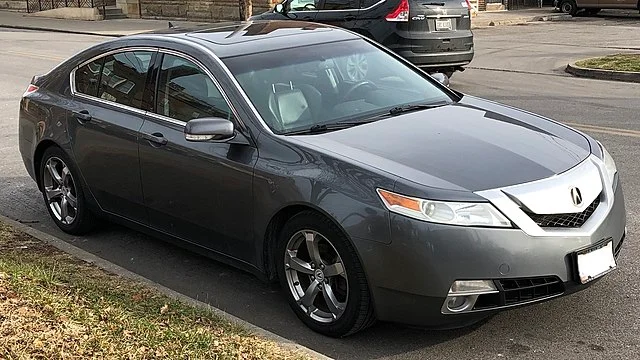Are you thinking of buying an Acura TL? It’s a car known for its sleek design and reliable performance.
When it comes to buying a used Acura TL, not all years are created equal. While the Acura TL has earned praise for its luxury, performance, and style, certain model years have been plagued with persistent issues that can lead to costly repairs and safety concerns.
This guide highlights the problematic Acura TL years you should avoid, dives into common defects and design flaws, and offers practical tips to help you make a confident and informed purchase. Whether you’re a first-time buyer or an Acura enthusiast, knowing which models are reliable and which to steer clear of is crucial for a worry-free ownership experience.
Acura TL Years to Avoid

📌 Key Takeaways
- Pro Tips: Spend on professional inspections and prioritize vehicles with consistent service records to avoid future headaches.
- Years to Avoid: Acura TL models from 1999–2003 and 2010 are notorious for transmission failures, excessive oil consumption, and electrical issues.
- Common Problems: Transmission breakdowns, flickering dashboard lights, and premature brake wear are among the most reported issues.
- Safer Choices: Models like 2008, 2011, and 2013 Acura TL are considered more reliable with upgraded engineering and fewer complaints.
- Inspection Matters: Always perform a thorough pre-purchase inspection and review the vehicle history report to spot hidden issues early.
- Maintenance Concerns: Older TL models may have higher repair costs and hard-to-find parts, making them less ideal for budget-conscious buyers.
Common Issues in Problematic Acura TL Models
When shopping for a used Acura TL, it’s essential to know which model years come with hidden headaches. Certain Acura TL models are notorious for recurring problems that can lead to expensive repairs and safety concerns. By understanding these issues in advance, you’ll be better equipped to avoid costly mistakes and choose a reliable vehicle.
Here’s a breakdown of the most common problems that have plagued specific Acura TL years:
Transmission Failures: A Costly Nightmare
One of the most significant complaints from Acura TL owners involves transmission failures, especially in models from the early 2000s. Drivers have reported sudden gear slippage, difficulty shifting, or complete transmission breakdowns—often without warning.
Imagine cruising on the highway, and suddenly your car struggles to change gears. Alarming, right?
Pro Tip: Before buying, check the vehicle’s service history for any transmission repairs or replacements. If you notice jerky shifting during a test drive, it’s a red flag.
Electrical System Glitches: Small Issues, Big Annoyances
Electrical issues can turn a routine drive into a frustrating experience. Some Acura TL models have been linked to:
- Flickering dashboard lights
- Malfunctioning infotainment systems
- Power window failures
- Erratic warning signals
Picture this: You start your car, and the dashboard stays dark. Or your headlights flicker at night. These aren’t just annoyances—they can compromise safety.
Pro Tip: Test all electronic features during inspection. Make sure lights, signals, and the sound system work flawlessly.
Excessive Oil Consumption: The Hidden Cost
Certain Acura TL years also suffer from high oil consumption. This means you might find yourself topping off oil frequently or facing potential engine damage if unnoticed.
Excessive oil use isn’t just an added expense—it often signals deeper engine problems.
Pro Tip: Check for oil leaks or burnt oil smells, and ask the seller about oil change frequency. Regular monitoring of oil levels can help prevent future engine troubles.
Why Knowing These Issues Matters
By staying aware of these common Acura TL problems, you’re not just protecting your wallet—you’re ensuring peace of mind. Focus on well-maintained models from more reliable years to avoid these pitfalls.

Years With the Most Complaints: Acura TL Models to Watch Out For
While the Acura TL has long been a favorite among car enthusiasts, not every model year has delivered the same level of reliability. Certain years have consistently received more owner complaints, raising concerns about costly repairs and frustrating driving experiences.
Here’s a closer look at the Acura TL years with the highest number of reported issues:
2002 Acura TL: Transmission Troubles Dominate
The 2002 Acura TL stands out for its high volume of owner complaints, particularly regarding transmission failures.
Common Issues:
- Sudden transmission failure—often without warning
- Flickering dashboard lights affecting night-time visibility
- Costly repairs averaging $3,000–$4,000 for transmission overhauls
💡 Did You Know? Many owners reported that transmission failures occurred as early as 70,000 miles, making this year a high-risk choice for used car buyers.
2003 Acura TL: Reliability Woes Continue
The 2003 Acura TL didn’t fare much better. Transmission issues remained widespread, with many drivers experiencing:
Common Issues:
- Slipping gears and hard shifting
- Engine stalling and frequent misfires
- High repair costs for engine and transmission replacements
Why It Matters: These problems raised serious safety concerns, especially during highway driving.
2010 Acura TL: Excessive Oil Use and Brake Problems
The 2010 Acura TL saw a shift in complaints, with many owners reporting:
🔧 Common Issues:
- Excessive oil consumption, requiring frequent top-ups
- Premature brake wear leading to higher maintenance costs
- Malfunctioning navigation systems with outdated maps
🛠️ What Owners Say: “I had to check oil levels every other week to avoid engine damage. Not what I expected from Acura.”
Why This Information Matters for Buyers
By avoiding these problematic years, you can save yourself from unexpected repairs and enjoy a more reliable driving experience. Always check service records and consider a professional inspection before buying a used Acura TL.
Factors Behind Common Acura TL Problems: What You Need to Know
Not all Acura TL models are created equal. While some years deliver exceptional reliability, others are plagued by recurring issues. Transmission failures, electrical glitches, and even interior design complaints have left many owners frustrated—and out of pocket.
So, what’s behind these problems? Let’s explore the three main factors contributing to the issues in certain Acura TL model years and how they impact your ownership experience.
1. Manufacturing Defects: The Hidden Troublemakers
Certain Acura TL models have suffered from manufacturing defects that led to premature failures.
Key Issues Linked to Defects:
- Transmission failures occurring well before 100,000 miles
- Faulty electrical systems causing flickering dashboards and inoperative features
💡 Example: Owners of early 2000s models often reported needing complete transmission replacements—an expensive and disruptive fix.
📌 Why It Matters: Manufacturing defects can leave you dealing with unexpected breakdowns and costly repairs, even with regular maintenance.
2. Design Flaws: Comfort and Performance Compromised
Some Acura TL years also struggle with design flaws that impact both usability and driving experience.
🚨 Common Complaints:
- Poor cabin ergonomics leading to discomfort on long drives
- Reduced visibility caused by thick pillars and awkward blind spots
- Navigation system placement making it harder to operate while driving
💡 Have you ever had to double-check blind spots more than usual? For many TL owners, this became a constant frustration.
📌 Why It Matters: Design flaws don’t just affect aesthetics—they can compromise safety and driver confidence.
3. Maintenance Challenges: When Routine Care Becomes a Hassle
Even with a reliable car, regular maintenance is key. But certain Acura TL years make this more difficult due to:
- Hard-to-find parts for older models
- Higher-than-average repair costs for specialized components
- Frequent visits to the mechanic for recurring issues
💡 Think about it: Would you prefer a car that’s easy and affordable to maintain—or one that keeps draining your time and wallet?
📌 Why It Matters: High maintenance demands can turn a dream car into a burden.
By understanding these contributing factors, you can avoid the most problematic Acura TL models and focus on years that deliver better reliability, lower maintenance costs, and a smoother ownership experience.
Alternatives and Better Acura TL Model Years
If you’re set on owning an Acura TL, choosing the right model year is key to avoiding costly headaches. While certain years are notorious for reliability issues, others stand out for their solid performance and lower maintenance costs.
Best Acura TL Years to Consider
While the 1999–2003 and 2010 models are known for transmission problems, later years show significant improvements.
✔ 2008 Acura TL – Praised for reliability and refined design
✔ 2011 Acura TL – Fewer complaints, improved transmission, and modern features
✔ 2013 Acura TL – One of the most dependable options with enhanced technology
💡 Why It Matters: These later models come with upgraded engineering, reducing the likelihood of major repairs.
Tips for Prospective Acura TL Buyers
Buying a used Acura TL doesn’t have to feel like a gamble. With the right approach, you can secure a dependable car and enjoy years of worry-free driving. Here’s how:
1. Inspection Guidelines: Look Beyond the Surface
A car may look sleek on the outside, but the real story lies under the hood.
- Conduct a thorough inspection of the engine, brakes, and suspension
- Listen for unusual noises during the test drive
- Check for uneven tire wear—it may indicate alignment or suspension issues
- Hire a professional mechanic for a pre-purchase inspection if you’re unsure
💡 Pro Tip: Spending a small amount on a mechanic today can save you thousands in unexpected repairs later.
2. The Importance of Vehicle History Reports
A vehicle history report is like a crystal ball—it reveals the car’s past and helps you avoid hidden surprises.
📌 What to Look For in a Report:
- Accident history – Has the car been involved in major crashes?
- Ownership records – Was it a single-owner vehicle or heavily traded?
- Service history – Regular maintenance indicates a well-cared-for car
💡 Imagine this: You buy a “perfect” car only to discover later it’s been in multiple accidents. A history report helps you avoid such costly surprises.
The Acura TL can be a rewarding choice—if you pick the right year and do your homework. Avoid models with known issues, prioritize thorough inspections, and always check the car’s history.
✅ With these steps, you’ll drive off confident that you’ve made a smart, informed decision.
Conclusion
The Acura TL can be a great investment if you choose the right year. By avoiding models with a history of reliability issues and focusing on well-maintained examples from more dependable years, you’ll save yourself from unexpected repairs and enjoy a smoother driving experience. Take time to inspect, research, and verify before buying—your future self (and wallet) will thank you. Armed with this knowledge, you’re now ready to navigate the used car market confidently and secure an Acura TL that delivers luxury without compromise.


